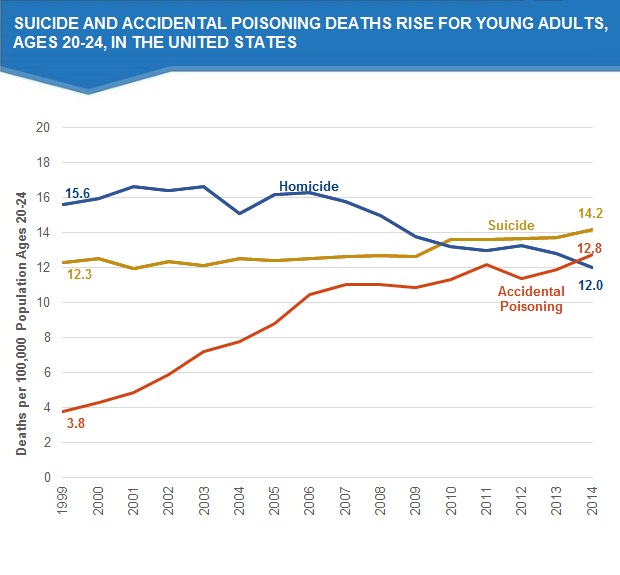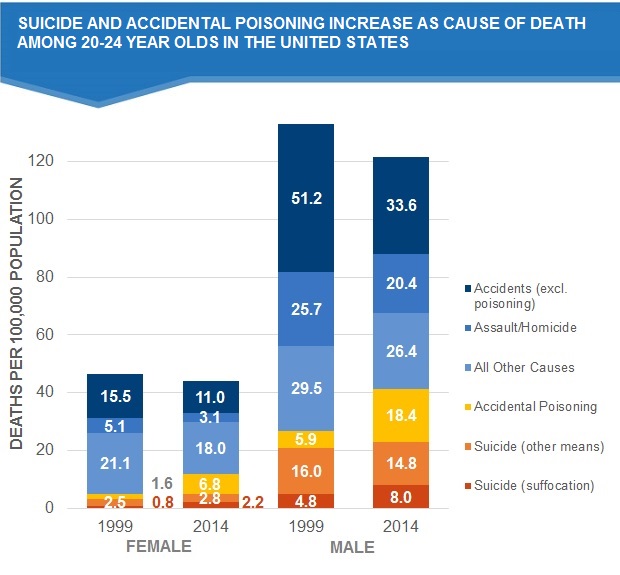Beth Jarosz
Senior Fellow, McCourt School of Public Policy at Georgetown University

February 22, 2016
Senior Fellow, McCourt School of Public Policy at Georgetown University
Program Director
(February 2016) Drug overdoses propelled the number of accidental poisonings above homicides as a cause of death among young adults ages 20 to 24 in the United States, according to 2014 data released recently by the Centers for Disease Control and Prevention (CDC).
The number of accidental poisonings—nearly all from drug overdoses—still trails the number of suicides, which overtook homicides as a cause of death in this age group in 2010 (see Figure 1). The results are based on an analysis of the CDC data by the Population Reference Bureau (PRB).
While mortality rates from both suicide and accidental poisoning increased among young adults over the past 15 years, the overall young adult mortality rate fell, partly due to declines in homicide and motor vehicle accidents.
Figure 1

Source: Centers for Disease Control and Prevention (CDC), National Center for Health Statistics, “Underlying Cause of Death 1999-2014,” CDC WONDER Online Database, accessed at http://wonder.cdc.gov/ucd-icd10.html, on Jan. 27, 2016.
Among young adults, the suicide rate increased from 12.3 deaths per 100,000 to 14.2 deaths per 100,000 between 1999 and 2014. This shift translated into more than 3,000 young adult deaths in 2014. Although men have higher rates of suicide than women, the rate for women has risen sharply in recent years, increasing by 47 percent from 1999 to 2014.
More suicide attempts do not appear to be driving this increase. Rather, young adults shifted to more lethal methods of self-harm. The frequency of suffocation (a particularly lethal form of self-harm which includes hanging) as the reported cause of suicide-related deaths among young adults nearly doubled over the past 15 years.1
Both men and women are increasingly likely to commit suicide by suffocation. For young women, this change drove the substantial increase in the suicide rate. From 1999 to 2014, the increase in suffocation deaths accounted for nearly 70 percent of the overall increase in suicide among young women (see Figure 2).
During the same time period, suicide rates among young men also increased, rising from 20.8 deaths per 100,000 to 22.9 deaths per 100,000. Similar to young women, rates of suffocation-related suicide among young men rose sharply from 4.8 deaths per 100,000 to 8 deaths per 100,000, yet this increase was partially offset by a decline in suicide by firearms.
The reasons why more young adults are using highly lethal means of self-harm remain unclear, creating a significant public health challenge.
Death rates from drug overdose and other forms of accidental poisoning among young adults more than tripled between 1999 and 2014, rising from 3.8 deaths per 100,000 to 12.8 deaths per 100,000. Almost 3,000 young adults died as a result of accidental poisoning in 2014, accounting for 15 percent of all young adult deaths.
In 2014, 96 percent of all accidental poisoning deaths among young adults were due to drug overdoses.
As with suicide, drug overdoses are a more frequent cause of death among young men than young women, but the rate of accidental poisoning/drug overdose grew substantially among both groups. Since 1999, the rate of drug overdose death for young men tripled, rising to 17.6 deaths per 100,000 in 2014. The rate for young women, while lower than for young men, quadrupled over the past 15 years, rising to 6.5 deaths per 100,000 in 2014. These sharp increases coincide with the increase in opioid-related deaths as reported by the CDC.2
The current drug overdose epidemic in the United States is the result of many factors, ranging from surging prescription drug use and abuse of opioid pain relievers to the growing availability and comparatively low price of heroin.3 These factors have contributed to a rise in preventable young adult deaths.
Overall young adult mortality rates increased from 1999 to 2006 (from 90.8 deaths per 100,000 to 100.5 deaths per 100,000), but have been declining since, dropping to 83.3 deaths per 100,000 in 2014. Much of the recent improvement is attributed to fewer deaths from transportation-related accidents as well as a lower homicide rate. The decline in transportation-related deaths mirrors a drop in overall miles driven that began during the recession.4 Thus, the overall mortality rate among young adults has improved in recent years, but the mortality rate for this age group would have continued to rise if it had not been for the reduction in transportation-related accidental deaths that occurred as driving reduced during the recession.

Source: Centers for Disease Control and Prevention (CDC), National Center for Health Statistics, “Underlying Cause of Death 1999-2014,” CDC WONDER Online Database, accessed at http://wonder.cdc.gov/ucd-icd10.html, on Jan. 27, 2016.
Despite general improvement in young adult mortality, the rise in suicide rates and deaths due to drug overdoses represent a significant and growing public health threat. Although more research is needed to determine the underlying factors behind these trends, they require action.
Suicide prevention strategies inclu de depression/suicide awareness programs, expanded access to mental health services, and programs that support vulnerable populations (groups at high risk of suicide include Native Americans, people struggling with gender and sexual identity, and those with mental health or substance abuse problems, among others). Overdose prevention strategies include family-, school-, and community-based substance abuse prevention and treatment programs. Given the links between substance abuse and suicide, substance abuse prevention and treatment could reduce the risk of death both from overdose and from suicide.5
